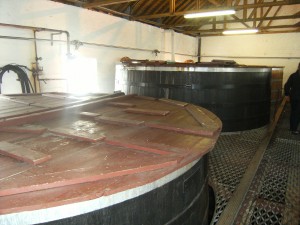Bruichladdich Whisky Academy Part 1

Learning to make whisky ~ what could be better?
Whisky for Girls was lucky enough to be sponsored by Mr. Jim McEwan for a week of Whisky Academy at Bruichladdich Distillery, with the Progressive Hebridean Distillers themselves.
Things got off to an auspicious start when I knocked on the head man’s office door at 5 to 8 am as instructed. Upon entering Jim said; ‘Oh……..!! Morning, Rachel. I thought you were coming next week…….’
Luckily, whisky is made every week, so without further ado, I was kitted out with steel-toe cap shoes and told where the tea and biscuits were before being pointed in the direction of the mash tun.
Bruichladdich mash tun is open topped so they put it through 4 waters as there will be more evaporation than in a covered mash tun. This mash tun was built in 1881 and is made from cast iron. Many of the distilleries now are putting in stainless steel mash tuns.

During mashing, the enzymes in the barley which developed during the malting process will, when heated in the water of the mash, react with the starches in the malt and produce maltose ~ a sugar. The first three waters are for mashing. The fourth water is for ‘sparging’, which means it is to wash out all the sugars from the malted barley. When this sugary water is drained off it is called ‘wort’. This is the product we want when making whisky. It’s the liquid we need. The washed-out barley is called ‘draff’ and the farmers feed it to the beasts.
A very interesting point here is that the mash man Graham checks for the stages of the mashing by listening. He listens for the change in the sound of the screw delivering the grist to join with the water to fill the initial mash. He listens to the change in sound when he thumps the grist bin so he knows how full it still is. He listens for the mill and is aware of all the sounds that tell him how things are progressing. In this age of computers, it was very refreshing to find this common sense way of working.
From the mash tun, the wort goes to the washbacks. It is here that the yeast will be added to start the fermenting process. Bruichladdich has 6 washbacks in the tun room and they are made from Oregon pine. The roof of the tun room has been raised and there is only one original washback left. The newer ones are much bigger, you can see the old, lower one in this picture.


The wort is cooled to around 20 degrees C then the yeast is added. Some yeasts can reproduce up to twenty times in well-aerated wort. Brewer’s yeast tends to be more prone to foaming, creating the lively head often seen in washbacks. In the past, this ‘foaming’ was controlled by beating the head with wooden sticks. Now it is more likely to be by mechanical switchers reminiscent of windscreen wiper blades. In Bruichladdich, the fermentation time is 60-80 hours (105 over the weekend).
At this time the strength of the wash will be around 7% alcohol ~ like a strong beer. Graham is measuring the alcohol volume of the wash. When I was younger we went into the distilleries in the winter after a dance to get a mug of the wash to warm us up! ~ (changed days now with all the health and safety regulations).
The next stage of my learning process was in the still house with PG.
I made Bruichladdich Organic! I turned valves, ran up and down stairs, checked the strength of the spirit, turned more valves, checked pressure gauges ~ you name it! It was like working in a spaceship. I used to think that the still-men had an easy job……….
Nowadays, much of the Stillman’s responsibility has been taken from him by computers. The computer gauges the strength of the liquid and decides when the spout will swing over and make the cut for the spirit. Not so in Bruichladdich. You have to keep your eye on the job ~ even tea breaks are taken in the still house!

PART II of THE BRUICHLADDICH SINGLE MALT ACADEMY report will follow in the next couple of days…… stay tuned!
